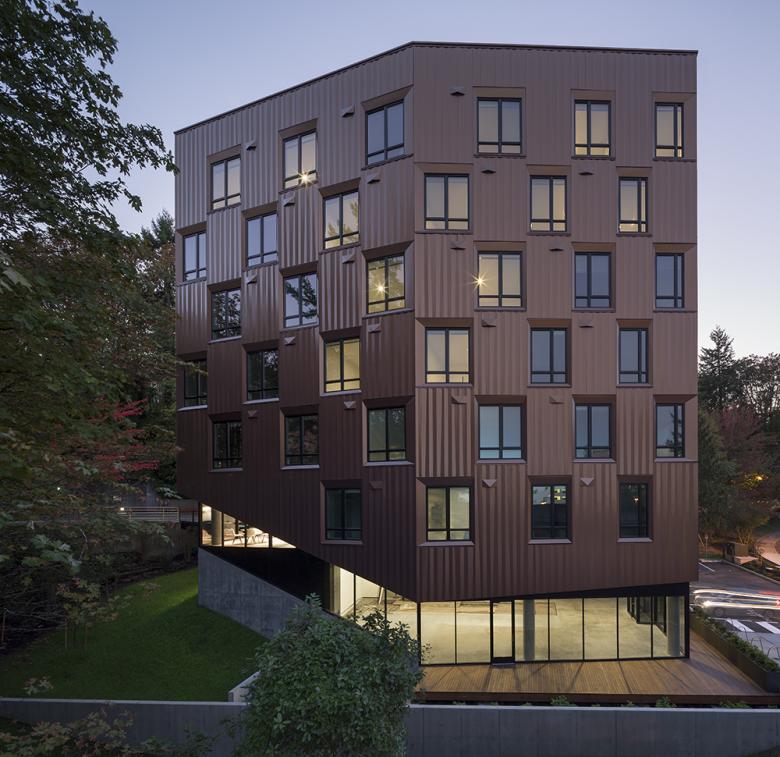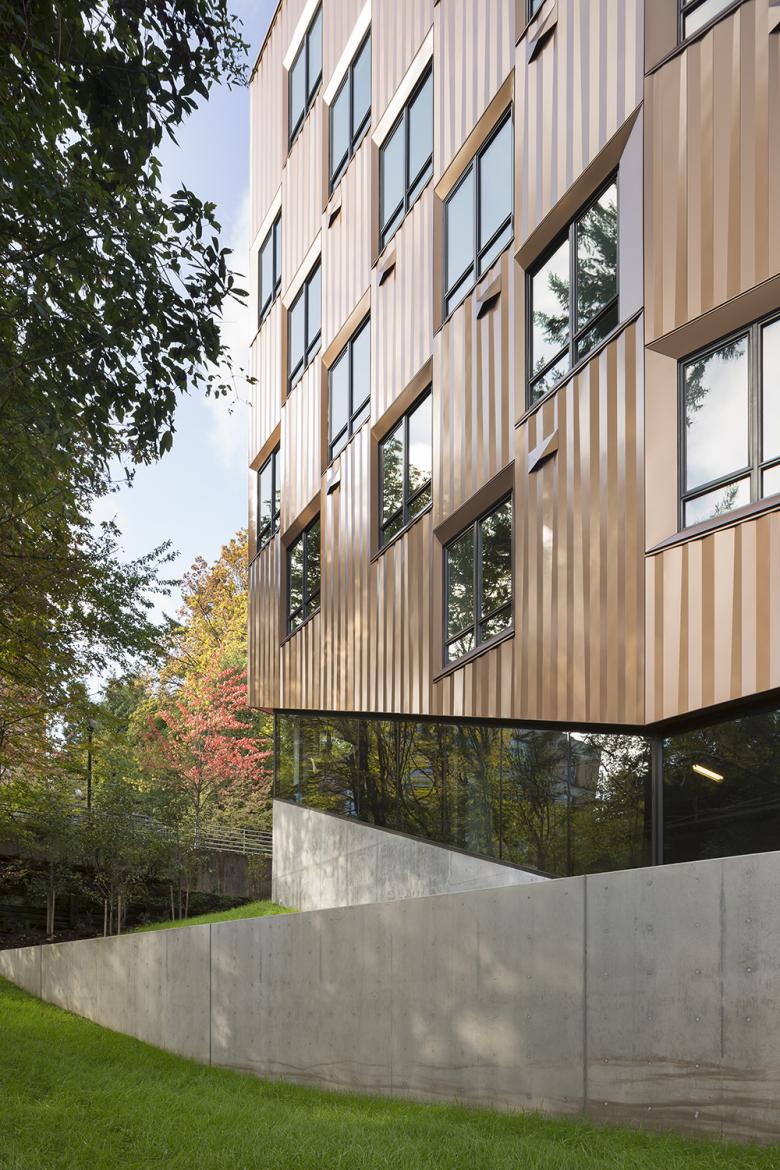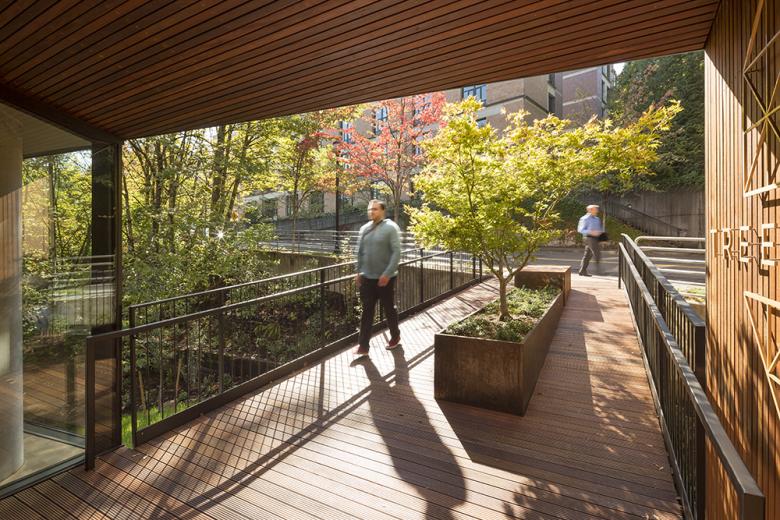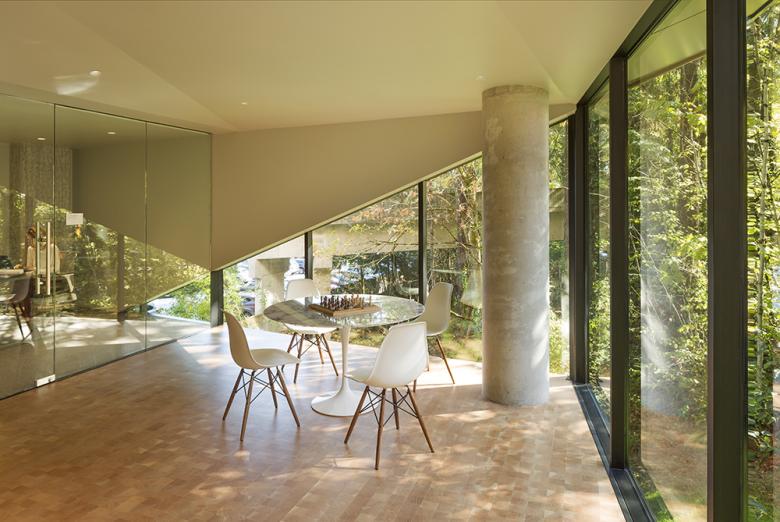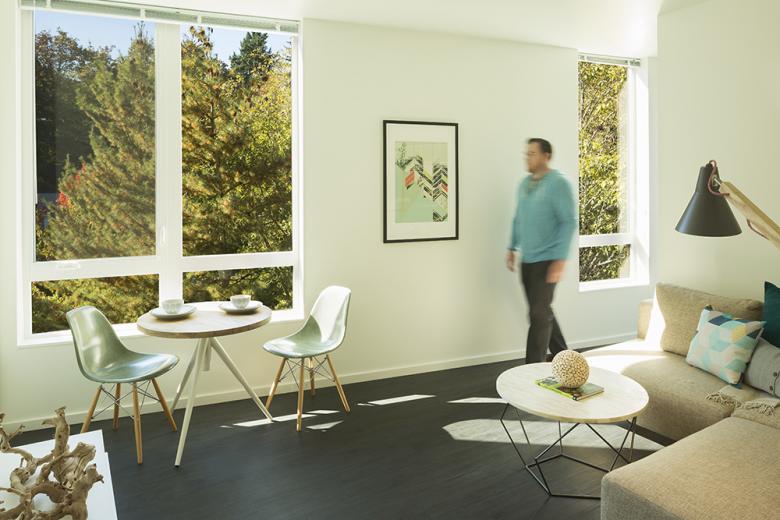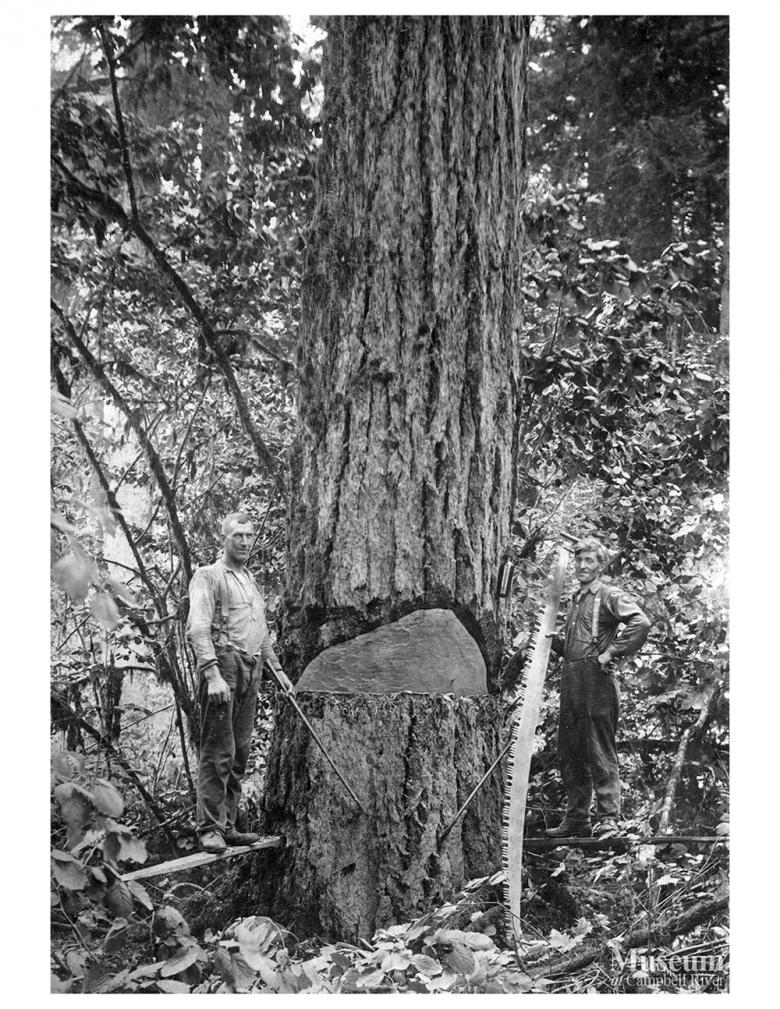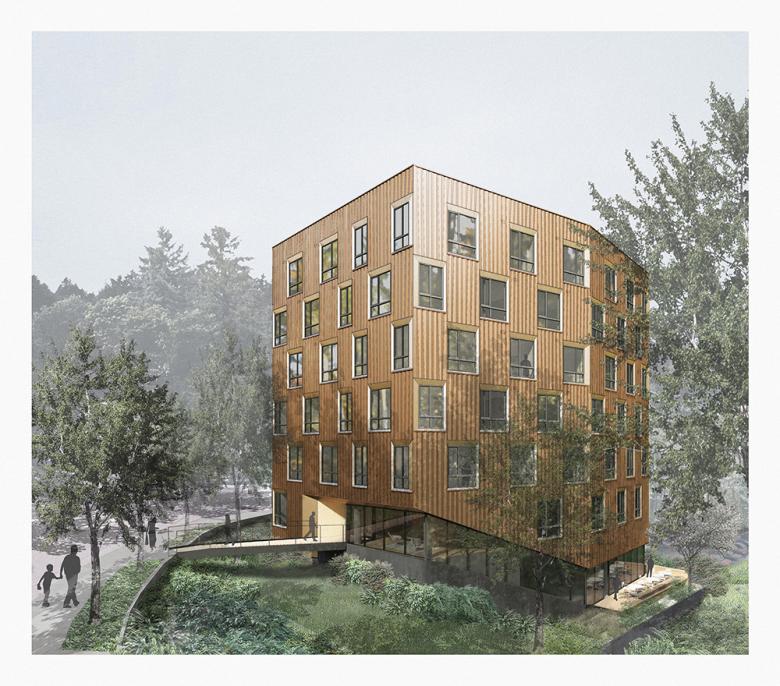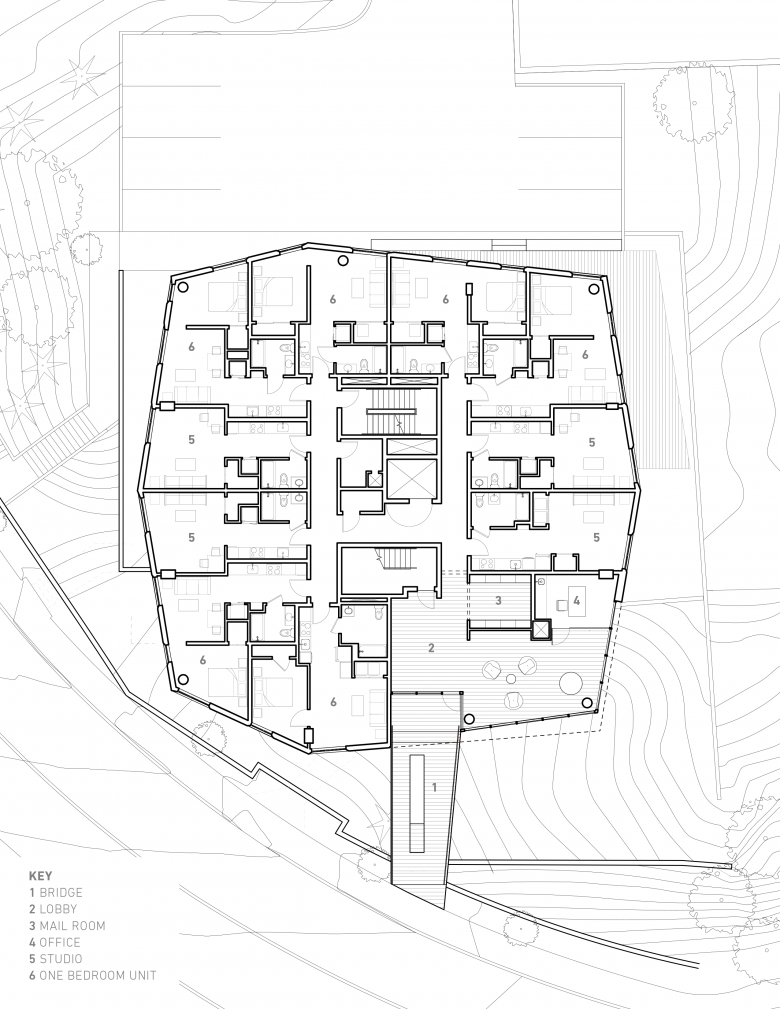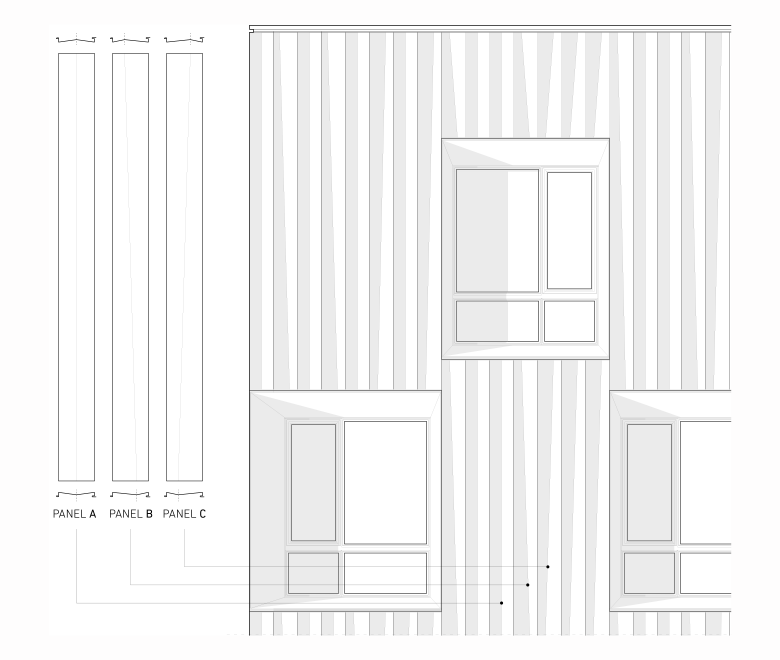TreeHouse
A precedent photo from LEVER Architecture shows a tree in the process of being felled, an angular chunk removed from its trunk. This image resonates with the section of the TreeHouse, which contends with a sharp drop from one side of the site to the other by a bridge and a glazed wrapping that follows the slope. LEVER's Thomas Robinson answered a few questions about the mixed-use building in Portland, Oregon.
What were the circumstances of receiving the commission for this project?
LEVER has collaborated with the developer project^ in Portland on the design and execution of a number of new buildings over the last five years. Each project starts with an open ended analysis of the potential of the site in terms of design, regulations, and economics. This approach allows both firms to work together and collaborate in the initial stages of the project to tailor a programmatic and economic design solution to fit the specifics of the location rather then start with a preconceived idea.
Please provide an overview of the project.
TreeHouse is a new mixed-use apartment building located on a steep and constricted site on the Oregon Health and Sciences University campus. The 7-story building is comprised of retail on the ground floor and 69 apartment living units above. Both retail and apartment units are intended to serve OHSU’s community of faculty, researchers, and students, as well as providing housing opportunities for the approximately 14,000 people who work in the Marquam Hill medical complex.
How does the design respond to the unique qualities of the site?
The design bridges the urban and topographical qualities of the campus by placing the building as an “in the round” object in the forest. Instead of cutting into the hill, the building form is carved to follow the landscape. From the interior entry lobby the experience of the forested landscape is framed. From the exterior, the building connects the upper level bridge entry to the lower level retail and rain garden landscape and deck that mitigates all storm water runoff.
The units are designed as series of interlocking volumes arranged around a compact central core core. The irregular octagonal plan was driven by mandated setback points required to allow for glazing on every face of the building. Windows have been carefully placed to maximize the daylight and experience of space in the studio- and one-bedroom flats.
The façade of the building is inspired by the textures and light of the forest. A continuous carved building skin is achieved by eliminating the expression of floor levels by incorporating all expansion joints into the custom window surrounds. Special attention was paid to the framing to allow for the precise placement of the windows at the corners as well as the detailing of thru façade venting. The skin has a consistent texture and pattern but intentional variety that gives the façade a dynamic quality that changes as you move along and around it and with the time of day.
How did the project change between the initial design stage and the completion of the building?
During the initial design phase, the team went through numerous iterations of how to address the 20’ (6 meter) drop from the upper road (Veterans Parkway) to the lower parking access. Understanding how the building meets and navigates the landscape was a key aspect of the project. Initially we had the retail on the upper level and the bridge connecting at the corner of the “cut” that forms the lobby. But after a number of iterations, we eventually came to a solution where the bridge connects to the back of the entry lobby and the glass wraps around and down the slope to retail/cafe at the lower level. The retail connects to a wrap around deck situated in a rain garden that treats all the runoff from the roof.
Was the project influenced by any trends in energy-conservation, construction, or design?
New buildings in Portland are governed by very strict storm water requirements. We are required to engineer sites to behave equivalent to a “green field” that absorb or infiltrate water in a major storm event. One of the simplest ways to meet these requirements is to provide a green roof. Another is to provide flow-thru planters (basically a version of a bio-swale you see in many city streets and parking lots) at the base of the building that is engineered to absorb and hold a large amount of water run off. We have been working with our landscape architect, Lango Hansen, on a number of projects to design these planters into the experience of the building. At TreeHouse the planter is a central element that defines the edge of the site and runs under the deck into culverts that are buried under the parking area.
What products or materials have contributed to the success of the completed building?
We have developed strong relationships with builders and fabricators over a number of projects. Their input and dedication is absolutely critical to executing high quality market rate projects for under $180 per/sf. At TreeHouse we worked extensively with our general contractor, Walsh Construction, and the sheet metal fabricator, Skyline, to develop and execute the metal skin. We worked with Walsh to develop a “zipper” like expansion joint at the floors that tracks around the building through the windows reveals and vertical panel joints. Skyline Sheet Metal helped us develop custom metal panel details and test out design moves that matched up with their production capabilities without driving up cost. Sixty percent of the panels at TreeHouse were fabricated in their shop with a custom angled break. The other 40% are a standard panel manufactured by Morin. We enjoy engaging with contractors early in the design process to connect ideas directly to the experience of the building.
Email interview conducted by John Hill.
TreeHouse
2015Portland, Oregon
Client
project^
Architect
LEVER Architecture
Portland, OR
Design Principal
Thomas Robinson
Project Architect
Doug Sheets
Project Manager
Jonathan Heppner
Project Team
Calista Fitzgerald, Jason Tand, Cecily Ryan
Associate Architect
LRS Architects
Structural Engineer
KPFF Structural Engineers
MEP/FP Engineer
MFIA Inc. Consulting Engineers
Landscape Architect
Lango Hansen
Lighting Designer
O Lighting
Interior Designer
LEVER Architecture
Contractor
Walsh Construction
Sheet Metal Fabrication
Skyline Sheet Metal
Building Area
46,500 sf
Photographs
Lara Swimmer
Drawings
LEVER Architecture

